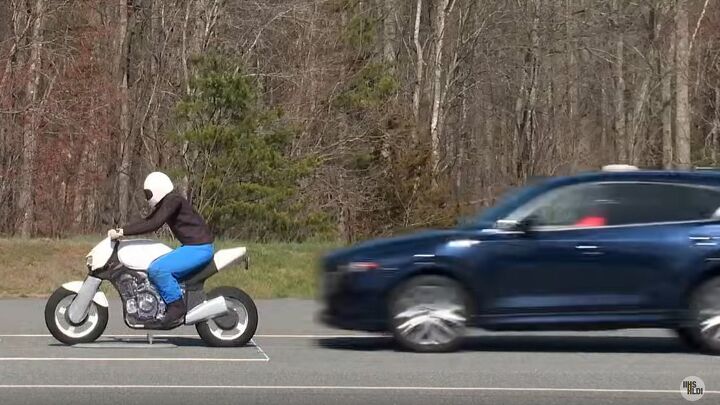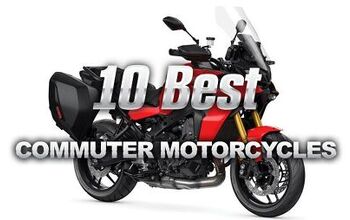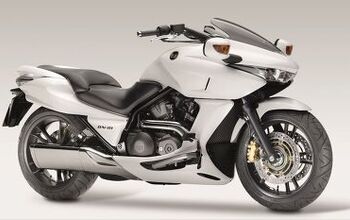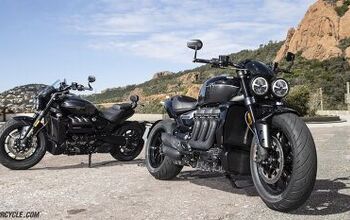Which Small SUVs Are Most Likely to Rear-End You?

IIHS test results are unsurprisingly disappointing
The Insurance Institute for Highway Safety has updated its vehicle-to-vehicle front collision testing to learn how well small SUVs do at avoiding hitting motorcycles – and as most motorcyclists suspect, the results were not very impressive.
The nonprofit organization regularly evaluates how well vehicle crash prevention technologies do against avoiding other cars, but the latest version of the test adds two different obstacles: motorcycles and semi trailers. The tests evaluate how effective a vehicle’s front collision warning and automatic emergency braking systems (AEB) are at detecting and reacting to each obstacle. The tests are conducted at different speeds, 31, 37 and 43 mph, and of particular importance for riders, whether a motorcycle is in the middle of the lane, or offset to the left or right.
For each test, an engineer drives the vehicle towards a target at the selected speeds and records how quickly the collision warning goes off, and how well the AEB systems slow the vehicle. The tester is awarded points if a collision warning comes up at least 2.1 seconds before a projected time of impact, and for substantial AEB speed reductions. AEB system scores are given twice the weight of collision warnings.
The IIHS tested 10 small SUVs, and only one, the Subaru Forester, received a “good” rating. The Honda CR-V and Toyota RAV4 were rated “acceptable”. The Ford Escape, Hyundai Tucson and Jeep Compass earned “marginal” ratings, while the Chevrolet Equinox, Mazda CX-5, Mitsubishi Outlander, and Volkswagen Taos were all rated as “poor”. The full IIHS front crash prevention ratings for small SUVs are available here, but here's what we learned from the motorcycle-specific results:
The Forester was able to provide timely warnings in all testing scenarios, and was able to slow down enough to avoid colliding with the target at 31 and 37 mph speeds. At 43 mph, AEB reduced the speed by an average of 32 mph when the motorcycle was in the center of the lane, and by 29 mph when it was offset. While that was considered “good”, it still means the Forester hit the motorcycle target at a speed of 12 mph when it was in the middle of the lane, and 14 mph when it was to the left or to the right. Either speed is still enough to do significant damage, but it only gets worse from here.
“Obviously, crashes that happen at higher speeds are more dangerous,” says David Kidd, IIHS senior research scientist, who led the development of the new evaluation. “Deadly underride crashes often occur when the struck vehicle is a large truck, and motorcyclists are frequently killed when they’re rear-ended by a passenger car, since their bike offers no protection from the impact.”
The CR-V also did well at 31 and 37 mph, but it failed to give a timely warning on a centered target at 43 mph, and only slowed to 16 mph. The CR-V did fare better with an off-center target at that speed, giving a timely warning and slowing down to an average of 7 mph.
The RAV4 received the same “acceptable” rating as the CR-V, but it didn’t do as well with the motorcycle-specific tests. The RAV4 failed to give a timely warning with an off-center motorcycle at 31 mph, and also failed at 43 mph regardless of lane positioning. Its AEB system also failed to avoid a collision with an off-center motorcycle at 37 mph, with an average speed reduction of 33 mph.
Of the three SUVs getting a “marginal” rating, the Hyundai Tucson’s AEB did better at avoiding collisions with a motorcycle, but struggled to give timely warnings at 31 and 37 mph. The Ford Escape’s AEB system was less effective, only avoiding collisions at 31 mph. The Jeep Compass received the same overall rating, but mainly because it was better at avoiding collisions with other cars and semis. With the motorcycle target, the Compass failed to give a timely warning at any speed, and its emergency braking systems failed to avoid hitting the target and had poorer speed reduction.
The Chevrolet Equinox, Mazda CX-5, Mitsubishi Outlander and Volkswagen Taos all had depressingly poor results to different degrees. Of this group, the Outlander fared the best with a motorcycle target, providing collision warnings in all scenarios, but its emergency braking was not able to avoid a collision with the motorcycle target at any speeds. The CX-5 and Taos were especially poor: their AEB systems didn’t react at all to a motorcycle at any speed or lane positioning.
So, what does this tell us? Nothing most riders didn’t already know. Safety technologies like collision warning systems and AEB can only do so much, and in some cases, not very much at all. In several cases, the tested vehicles did significantly worse at detecting motorcycles than they did with larger vehicles.
That’s not to say they are completely useless. IIHS researchers examined police-reported crash data in 18 states from 2017 to 2021, and found that these safety systems were a factor in reducing motorcycle crashes by 41%. Still, none of this tech can replace a safe and attentive driver, and none of this data will provide much solace to riders.
In a press release, speaking mainly of autonomous vehicles but also other crash avoidance systems, Nick Haris, AMA government relations director says: “It’s astounding that, despite laying out clear and specific safety recommendations and the many concerns raised by various stakeholders calling for the regulation of this technology, we are continuing to fight the same battle,
“We urge developers and regulators to prioritize the inclusion of motorcyclists in the design, testing and implementation of AV systems to prevent future tragedies.”
Become a Motorcycle.com insider. Get the latest motorcycle news first by subscribing to our newsletter here.

Dennis has been a part of the Motorcycle.com team since 2008, and through his tenure, has developed a firm grasp of industry trends, and a solid sense of what's to come. A bloodhound when it comes to tracking information on new motorcycles, if there's a new model on the horizon, you'll probably hear about it from him first.
More by Dennis Chung






























Comments
Join the conversation
We can install driving radar which will keep us safe, I recently purchased innovv's driving radar which detects approaching pedestrians and cars and alerts us if a pedestrian or car is approaching.
It is not the type of car but the idiot driving it who is on a cell phone. I would know having been 5 months on crutches with a titanium rod now in my tibia. You want to drive, drive. You want to yak, find an effing phone booth.
The engineers of these robotic self-driving systems have no incentive to make their systems "see" motorcycles, so don't look for that capability anytime soon. Instead, how about someone - maybe IIHS? maybe the motorcycle manufacturers?- designing a small, light, and cheap radar reflector that mounts easily on the rear of bikes, to make us more visible to these dumb systems? The reflectors commonly used on the masts of small sailboats were designed for a similar need. Should not be that difficult?